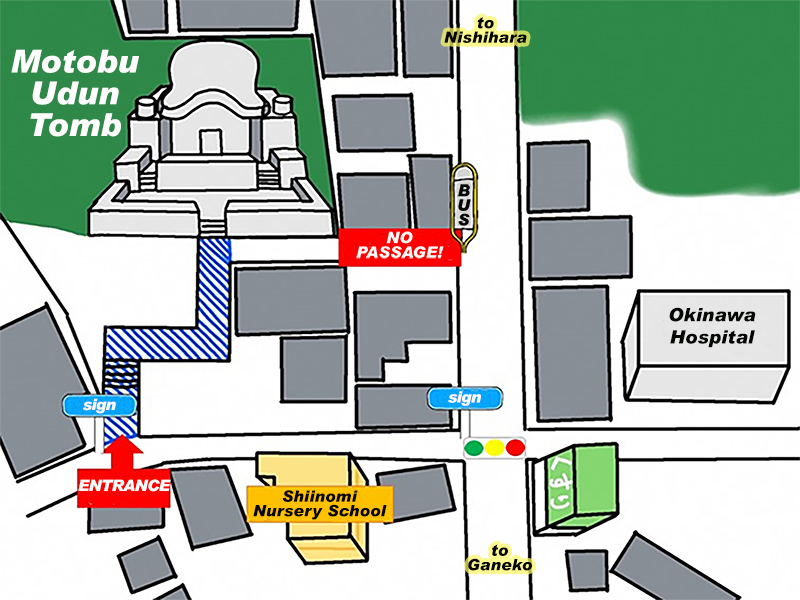In 2021, after several years of research and reconstruction, the Motobu Udun Tomb was designated a cultural property by Ginowan City. The tomb is of interest as a historical site, but it also has high value as a place related to the House of Motobu, one of Okinawa’s premiere martial arts famlies. Therefore, it is a destination for karate fans from all over the world who visit Okinawa.
At the tomb itself is a Japanese language text explaining the major features of the tomb, its history and the main characters related to it. There is also an English text added to it. As is typical for historical monuments in Okinawa, here too the English translation is an abbreviated form of the original Japanese text. For this reason, I have prepared an English translation which I share below for your convenience.
Description
The Motobu Udun Tomb is a turtleback tomb (kamekōbaka) located in Genako in today’s Ginowan, Okinawa. The tomb belongs to the House of Motobu whose origin is Prince Motobu Chōhei (aka Shō Kōshin, 1655–1687), the 6th son of the 10th King Shō Shitsu (1629–1668) of the Second Royal Shō Dynasty of Ryūkyū.
According to a description in the Ōdaiki, a dynastic record of the Second Royal Shō Dynasty, “the remains originally enshrined in Sueyoshi in Shuri were transferred to Ganeko.” According to this, the tomb was likely built after 1694, when founder Chōhei’s bones were washed before placing them in the funerary urn.
Both ends of the tomb’s “eyebrows” (mayu) are gently curved and similar to other ancient turtleback tombs which have been reconstructed in the city area until now. The front of the burial chamber is laid out in cut-stone masonry (aikata-zumi), a method of stacking stones by carving them so that they mesh with each other while utilizing the natural shape of the stones. Its left and right sleeve stones (sudi-ishi) are made of two layers of “cloth piling” (nunozumi in which rows of stones are horizontally laid on top of one another, so called because they resemble woven fabric (nuno), and the turtleback of the upper part of the tomb is also entirely covered with stones. In addition, curb stones are arranged so as to surround the entire tomb, and the top part is further paved with stones.
The graveyard is divided into an inner (first) yard and an outer (second) yard. The inner (first) yard is the open area in front of the entrance to the burial chamber and is elevated from the outer yard by about of 1m, which is similar to in case of the Ginowan Udun Tomb. The height difference from the graveyard entrance (outer yard) to the front of the burial chamber (inner yard) is believed to represent the high social status of the deceased as a member of the royal family, and the high prestige of the Motobu Udun.
The interior of the burial chamber has an arched ceiling, with an elevated ledge on each side, and a total of ten carved and decorated pottery containers for storing the bones (zushigame) have been confirmed. From the inscription engraved on the bone containers made of limestone in the center of the inner ledge, it is surmised that the remains of Prince Motobu Chōhei, the founder of the House of Motobu, and his wife are enshrined here.
The private road that remained on the north side of the graveyard entrance is not straight but bends at right angles at about every ten meters, and according to the tradition handed down in the family, the grave site was about 6,600 m², so the cemetery area was quite large at the time of construction, and the above-mentioned private road was originally located within the cemetery area. Therefore, it is thought that the approach to the tomb had the function of repelling evil spirits (yanamungēshi).
The Motobu Udun Tomb is considered extremely valuable for research on the relationship between the royal family and the Ginowan District of the time, the construction of ancient turtleback tombs, and their transformations.
On February 25, 2021, the Motobu Udun Tomb was designated as a cultural property historical site by Ginowan City in recognition of its high value as a material that unravels the relationship between the Ginowan District and royal descendants at that time.
The designation criteria are described in the “Guidelines for Criteria for the Designation and Accreditation of Cultural Properties of Ginowan City” (Ginowan City Board of Education, Directive No. 6). It defines “Criteria for the designation as a city-designated historic site, place of scenic beauty, or natural monument,” and includes “Tombs and stone monuments bearing an inscription” among the “”Historic Sites” which are “indispensable for a correct understanding of the history of Ginowan and that have academic value in terms of scale, remains, excavated artifacts, etc.”
Location, and things to observe when visiting
The Motobu Udun Tomb is located in Ganeko, on a hill on the south side of Shiinomi Nursery School, across the road from Okinawa Hospital, near the border between Ginowan City and Nishihara Town.
Address: 2 Chome-9 Ganeko, Ginowan, Okinawa 901-2214, Japan
Note: The passage from Prefectural Route 34 and the area around the grave are private property. Do not use this passage.
To enter the Motobu Udun Tomb, walk along the street at Shiinomi Nursery School.
Follow the two blue and white road signs here and here that say “Motobu-udun Tomb.”
In the meantime, I have created a Wikipedia as well, which has some cool photos: Motobu Udun Tomb – Wikipedia!
© 2023, Andreas Quast. All rights reserved.

